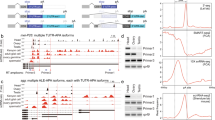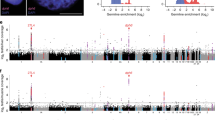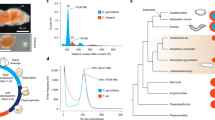Key Points
-
During development of a somatic nucleus (macronucleus) from a germline nucleus (micronucleus) in hypotrichous ciliates, 95% or more of the DNA sequences are eliminated.
-
Elimination of DNA sequences converts very high molecular weight micronuclear DNA to very low molecular weight macronuclear DNA.
-
With rare exceptions, each of the thousands of different, short macronuclear DNA molecules (400 to 15,000 bp) encodes a single gene.
-
In the micronucleus, genes are interrupted by short, multiple, (A+T)-rich, non-coding sequences called internal eliminated segments or IESs. IESs are spliced out of genes during macronuclear development.
-
During evolution, IESs shift along DNA of micronuclear genes without changing the nucleotide sequences of the genes. IES shifting seems to occur by point mutations.
-
In some germline genes, gene segments created by the presence of IESs are in disorder (including inversions), creating scrambled genes. Scrambled genes are unscrambled during macronuclear development.
-
The elaborate DNA manipulations during macronuclear development are accompanied by activation of the silent micronuclear genes into actively transcribed macronuclear genes.
-
The spectacular contortions of germline DNA in hypotrichous ciliates may be important in the evolution of these organisms.
Abstract
In some ciliates, the DNA sequences of the germline genomes have been profoundly modified during evolution, providing unprecedented examples of germline DNA malleability. Although the significance of the modifications and malleability is unclear, they may reflect the evolution of mechanisms that facilitate evolution. Because of the modifications, these ciliates must perform remarkable feats of cutting, splicing, rearrangement and elimination of DNA sequences to convert the chromosomal DNA in the germline genome (micronuclear genome) into gene-sized DNA molecules in the somatic genome (macronuclear genome). How these manipulations of DNA are guided and carried out is largely unknown. However, the organization and manipulation of ciliate DNA sequences are new phenomena that expand a general appreciation for the flexibility of DNA in evolution and development.
This is a preview of subscription content, access via your institution
Access options
Subscribe to this journal
Receive 12 print issues and online access
$189.00 per year
only $15.75 per issue
Buy this article
- Purchase on Springer Link
- Instant access to full article PDF
Prices may be subject to local taxes which are calculated during checkout







Similar content being viewed by others
References
Wright, A.-D. G. & Lynn, D. H. Maximum ages of ciliate lineages estimated using a small subunit rRNA molecular clock: Crown eukaryotes date back to the Paleoproterozoic. Arch. Protistenkd. 148, 329–341 ( 1997).
Blackburn, E. H. & Gall, J. G. A tandemly repeated sequence at the termini of the extrachromosomal ribosomal RNA genes in Tetrahymena. J. Mol. Biol. 120, 33– 53 (1978).
Greider, C. W. & Blackburn, E. H. Identification of a specific telomere terminal transferase activity in Tetrahymena extracts. Cell 43, 405–413 ( 1985).
Price, C. M. Telomere-binding proteins of ciliated protozoa. Nucleic Acids Mol. Biol. 9, 299–307 ( 1995).
Horvath, M. P., Schweiker, V. L., Bevilacqua, J. M., Ruggles, J. A. & Schultz, S. C. Crystal structure of the Oxytricha nova telomere end binding protein complexed with single strand DNA. Cell 95, 963–974 (1998).
Zahler, A. M. and Prescott, D. M. Telomere terminal transferase activity in the hypotrichous ciliate Oxytricha nova and a model for replication of the ends of linear DNA molecules. Nucleic Acids Res. 16, 6953–6972 ( 1988).
Brehm, S. L. & Cech, T. R. Fate of an intervening sequence ribonucleic acid: Excision and cyclization of the Tetrahymena ribosomal RNA intervening sequence in vivo. Biochemistry 22, 2390–2397 (1983).
Griffith, J. D. et al. Mammalian telomeres end in a large duplex loop. Cell 97, 503–514 ( 1999).
Murti, K. G. & Prescott, D. M. Telomeres of polytene chromosomes in a ciliated protozoan terminate in duplex DNA loops. Proc. Natl Acad. Sci. USA 96, 14436–14439 (1999).
Klobutcher, L. A. et al. Conserved DNA sequences adjacent to chromosome fragmentation sites in Euplotes crassus. Nucleic Acids Res. 26, 4230–4240 (1998).
Klobutcher, L. A. Characterization of in vivo developmental chromosome fragmentation intermediates in Euplotes crassus. Mol. Cell 4, 695–704 (1999).
Sueoka, N. Intrastrand parity rules of DNA base composition and usage biases of synonymous codons. J. Mol. Evol. 40, 318– 325 (1995); erratum 42, 323 (1996).
Frank, A. C. & Lobry, J. R. Asymmetric substitution patterns: a review of possible underlying mutational or selective mechanisms. Gene 238, 65–77 ( 1999).
Klobutcher, L. A., Jahn, C. L. & Prescott, D. M. Internal sequences are eliminated from genes during macronuclear development in the ciliated protozoan Oxytricha nova. Cell 36, 1045–1055 ( 1984).The original discovery of internal eliminated segments in a germline gene of a hypotrich.
DuBois, M. L. & Prescott, D. M. Volatility of IESs in germline genes of hypotrichous ciliates. Mol. Cell. Biol. 17 , 326–337 (1997). The discovery of internal eliminated segment shifting in the actin I gene of hypotrichs.
Tausta, S. L. & Klobutcher, L. A. Internal eliminated sequences are removed prior to chromosome fragmentation during development in Euplotes crassus. Nucleic Acids Res. 18, 845– 853 (1990).This work proved that excision of internal eliminated segments leaves intact the polytene chromosomes formed during macronuclear development, and is apparently unrelated mechanistically to the eventual breakup of the polytene chromosomes into gene-sized DNA molecules.
Hoffman, D. C. & Prescott, D. M. Evolution of internal eliminated segments and scrambling in the micronuclear gene encoding DNA polymerase α in two Oxytricha species. Nucleic Acids Res. 25, 1883–1889 (1997).The complex scrambled patterns in the gene that encodes DNA polymerase α in two hypotrich species.
Prescott, D. M. & DuBois, M. L. Internal eliminated segments (IESs) of Oxytrichidae. J. Euk. Microbiol. 43, 432–441 (1996).
Duharcourt, S., Keller, A.-M. & Meyer, E. Homology-dependent maternal inhibition of developmental excision of internal eliminated sequences in Paramecium tetraurelia. Mol. Cell. Biol. 18, 7075–7085 (1998).These experiments in Paramecium implicate the old macronucleus in directing the excision of internal eliminated segments in the developing macronucleus.
Forney, J. D., Yantiri, F. & Mikami, K. Developmentally controlled rearrangement of surface protein genes in Paramecium tetraurelia. J. Euk. Microbiol. 43, 462–467 ( 1996).
Prescott, D. M. & Greslin, A. F. Scrambled actin I gene in the micronucleus of Oxytricha nova. Dev. Genet. 13, 66–74 ( 1992).
Prescott, D. M. The evolutionary scrambling and developmental unscrambling of germline genes in hypotrichous ciliates. Nucleic Acids Res. 27, 1243–1250 (1999).
Mitcham, J. L., Lynn, A. J. & Prescott, D. M. Analysis of a scrambled gene: The gene encoding α-telomere-binding protein in Oxytricha nova. Genes Dev. 6, 788–800 (1992).
Prescott, J. D., DuBois, M. L. & Prescott, D. M. Evolution of the scrambled germline gene encoding α-telomere binding protein in three hypotrichous ciliates. Chromosoma 107, 293–303 (1998). A model of the origin of scrambling of the gene that encodes α-telomere-binding protein is presented, based on the structure of the germline gene in three hypotrichs.
Hoffman, D. C. & Prescott, D. M. The germline gene encoding DNA polymerase α in the hypotrichous ciliate Oxytricha nova is extremely scrambled. Nucleic Acids Res. 24, 3337–3340 (1996).
Landweber, L. F., Kuo, T.-C. & Curtis, E. A. Evolution and assembly of an extremely scrambled gene. Proc. Natl Acad. Sci. USA 97, 3298 –3303 (2000).
DuBois, M. & Prescott, D. M. Scrambling of the actin I gene in two Oxytricha species. Proc. Natl Acad. Sci. USA 92, 3888–3892 ( 1995).
Radman, M., Matic, I. & Taddei, F. Evolution of evolvability. Ann. NY Acad. Sci. 870, 146–155 ( 1999).
Prescott, D. M. Invention and mystery in hypotrich DNA. J. Euk. Microbiol. 45, 575–581 (1998).
Acknowledgements
This work is supported by the NIGMS and the NSF.
Author information
Authors and Affiliations
Related links
Related links
DATABASE LINKS
FURTHER INFORMATION
ENCYCLOPEDIA OF LIFE SCIENCES
Glossary
- CILIATES
-
Single-celled organisms containing a micronucleus (germline nucleus), a macronucleus (somatic nucleus) and cilia for swimming and food capture.
- RNA SELF-SPLICING
-
Removal of the intron sequence from precursor RNA and splicing of the mature RNA by catalytic action of the intron RNA, showing the enzyme-like activity of RNA.
- POLYTENE CHROMOSOME
-
A giant chromosome formed by many replications of the DNA. The replicated DNA molecules tightly align side-by-side in parallel register, creating a non-mitotic chromosome visible by light microscopy.
- SEQUENCE COMPLEXITY
-
The number of different DNA sequences in a genome, originally measured by the rate of reassociation of heat-denatured DNA.
- PARITY RULE 2
-
This rule derives from parity rule 1. In the absence of strand bias for mutation or selection, A = T and C = G within a strand of the double helix.
- PARITY RULE 1
-
In the absence of strand bias for mutation or selection, the 12 substitution rates between all four bases reduce to six rates, that is A→T = T→A, G→C = C→G, A→G = T→C, G→A = C→T, C→A = G→T and A→C = T→G.
- TRANSITION
-
A mutation in which a purine is replaced by a purine, or a pyrimidine is replaced by a pyrimidine.
- TRANSVERSION
-
A mutation in which a pyrimidine is replaced by a purine or vice versa.
Rights and permissions
About this article
Cite this article
Prescott, D. Genome gymnastics: unique modes of dna evolution and processing in ciliates . Nat Rev Genet 1, 191–198 (2000). https://doi.org/10.1038/35042057
Issue Date:
DOI: https://doi.org/10.1038/35042057
This article is cited by
-
Bacillus subtilis Engagement Induced via Sporulation: a Case of Bacterial Communication
Brazilian Journal of Physics (2022)
-
The completed macronuclear genome of a model ciliate Tetrahymena thermophila and its application in genome scrambling and copy number analyses
Science China Life Sciences (2020)
-
A paradox: rapid evolution rates of germline-limited sequences are associated with conserved patterns of rearrangements in cryptic species of Chilodonella uncinata (Protista, Ciliophora)
Science China Life Sciences (2018)
-
Non-coding RNAs mediate the rearrangements of genomic DNA in ciliates
Science China Life Sciences (2013)



